
Friday, August 31, 2007
Wednesday, August 29, 2007
Sermon audio now ready
Here are two sermons that I've recently given. I'm working to make audio files for these available on a somewhat regular basis (I don't preach every week, and someone else does the recording).
"Lord, Teach us to Pray" from 29 July 2007 at St Alban's.
"Vanity of Vanities? or Mystery of Mysteries?" from 5 August 2007. Note that the file begins with music.
"The Pursuit of Holiness" from 19 August 2007. Note that the audio is poor for the first 5 minutes or so while I am on the chancel steps for the children's sermon. After that, it sounds great.
"Lord, Teach us to Pray" from 29 July 2007 at St Alban's.
"Vanity of Vanities? or Mystery of Mysteries?" from 5 August 2007. Note that the file begins with music.
"The Pursuit of Holiness" from 19 August 2007. Note that the audio is poor for the first 5 minutes or so while I am on the chancel steps for the children's sermon. After that, it sounds great.
Sunday, August 26, 2007
Prayer Book revision
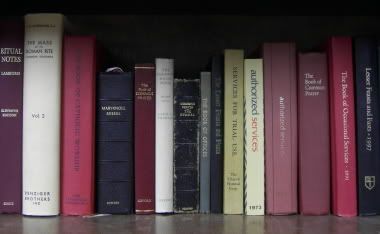
One thing that is inevitable (except in England, where Parliament makes it impractical) is ongoing revision of the Book of Common Prayer. The most recent, and most drastic, American revision is from 1979. It has its problems, as did the previous revision from 1928. While it is not around the corner, the current edition will be revised again at some point. Here are some of my suggestions for when that day comes.
“And with your spirit.” The mistranslation of Et cum spiritu tuo as “And also with you” comes from the English text of the Roman Missal. Now that Rome is correcting it’s translation, it should follow that we would correct ours. I believe the Lutheran Church already uses “And with your spirit.” I’m sure that other churches will make the most as the corrected translation becomes commonplace through Rome’s usage. It would also serve well for Anglicans in making the discrepancy between a mixed group of Rite One (“And with thy spirit”) and Rite Two (“And also with you”) Episcopalians much less distracting.
New Prayers and Blessings. In many parishes, it is common to have blessings for birthdays and wedding anniversaries. The 1979 Prayer Book has two prayers for a birthday (#50 and #51 on page 830) and no prayers for a wedding anniversary (although #50 would fit any kind of annual celebration). Some clergy have substituted an entirely inappropriate prayer—the nuptial blessing from the marriage rite. There are two main problems with this. First, it should only be given once in a lifetime. Second, there may be people who are not eligible to be married in the church and thus should not receive this blessing at all. I have used the collect for the marriage liturgy reworded for the past tense (“vows they have made”), but it is not rubrically correct to do so. A prayer should be supplied in the next revision to meet this need.
Likewise, many parishes have pet and animal blessings on the feast of St Francis of Assisi, but there is no form for this in either the Prayer Book or the Book of Occasional Services. A form should be provided, both for the sake of convenience, and for preventing doctrinal irregularity in praying extemporaneously about this sensitive subject.
The Prayers in Morning and Evening Prayer. I would add the Kyrie just before the Lord’s Prayer and I would change to the shorter and more ancient form of the Lord’s Prayer (i.e., without the doxology). This usage would return to the 1549 Prayer Book and pre-Reformation forms. It would also bring the pattern into alignment with the form in the minor offices and the Litany.
Apostles’ Creed in Matrimony and Burial. The rubric already says it may be used, but I would go ahead and add the text of the Apostles’ Creed to Burial: Rite One and to The Celebration and Blessing of a Marriage. These are two occasions where many visitors will normally be present and having every one flip back to the creed and then back to the other liturgy seems unnecessary. It is certainly not a user-friendly approach, and it has the side effect of discouraging the use of the Apostles’ Creed on these occasions.
The Reconciliation of a Penitent. I would remove the newly composed absolution, (worded “absolve you through my ministry”). It is based on the passive Eastern Orthodox pattern, but is not the active wording familiar to many through film and television. It leaves the uninitiated feeling like they are still waiting to be absolved. I would also provide a list of penitential psalms, perhaps useful for penances. The dismissal should remove the option, which is unnecessary, and simply state “Go in peace, and pray for me, a sinner.”
I would also take away the text for the declaration of forgiveness to be used by a lay person or a deacon after hearing a confession (“Our Lord Jesus Christ, who offered himself to be sacrificed for us to the Father, forgives your sins by the grace of the Holy Spirit. Amen.”). Instead, I would replace it with: If the ministrations of a priest cannot be obtained, a deacon or lay person hearing the confession may respond by encouraging them to make this confession before a priest a soon as possible and by saying “God is ready to pardon, gracious and merciful, slow to anger and abundant in kindness. He does not forsake those who are truly penitent.” The old sentence sounds too much like an absolution, which may lead someone to thing that they no longer need to seek a priest. The new sentence is modeled after Nehemiah 9:17.
The Ministration to the Sick. The scripture selections are already noted in the Prayer Book, but I would add the text of the readings themselves. This is for the sake of convenience. The priest will already be bringing a number of items on this occasion, and needing one less book is very helpful.
At the section for the laying on of hands and anointing with oil, I would add a rubric stating that no one may be anointed by proxy (I have encountered this abuse in some charismatic circles). Also, the conditional rubric in the middle of page 457 should be changed to simple read, “It is suitable to administer the reserved sacrament outside the Church in one kind only.” This conforms with common practice. I have never encountered the reserved Sacrament being administered in both kinds in the home or hospital. Indeed, in many places the Sacrament is only reserved in one kind to begin with.
Communion under Special Circumstances. This rite is essentially for administering Holy Communion to shut-ins. Since most of the people to whom this ministry now applies are elderly and were formed under the Rite One or 1928 Prayer Book tradition, it is appropriate that a Rite One form should also be provided. I would add the same rubric as above about administering the Sacrament in one kind.
An Order for Celebrating the Holy Eucharist. This is commonly known as “Rite Three” and is not often used. In my view, such self-composed liturgies stand far outside the tradition. Even in the early centuries, liturgical forms quickly crystallized into set patterns, modeled after the uses in the patriarchal sees. As it encourages personal creativity in composing liturgical forms, it also discourages conformity and is thus alien to the spirit of liturgy. I would eliminate this section entirely.
Prayers of the People. I would return some mention of the duty of civil servants to punish wickedness and vice and to maintain virtue and freedom of religion to the “Prayer for the whole state of Christ’s Church and the world” in Rite One. There is also one change that I would make in Form I. There is one petition, the second to last on page 385, which neither ends in the concluding for nor the standard form of “let us pray to the Lord.” Because it changes from speaking to the people to speaking to God, this one petition ends in, “by thy grace.” Every time that I’ve heard this used, it has ended up being a train wreck. I would rewrite it so that it is directed toward the people like each of the other petitions and keeps the standard ending.
The Holy Eucharist. There are a number of changes that I would make here, though mostly concerning options and titles. I would change the title of both parts to “The Liturgy of the Word of God” and “The Liturgy of the Holy Communion.” This seems more natural to me, while the shortened form seems too elliptical.
The Post-Communion Prayer. I would have only one post-communion prayer per rite. To me, this is one of those prayers that one should ideally be able to recite from memory. I would eliminate one of the options for the post-communion prayer in Rite Two. I would probably keep the first one, which begins “Eternal God . . .” because the other is more similar to the wording of Rite One and the subtle differences would trip up someone who normally worships in the other rite. I would also eliminate the proper post-communion prayers for marriages, ordinations, and burials. I think they are simply unnecessary and the less flipping around in the book at this moment of the liturgy, the better. Also, the post-communion prayers should be modified to reflect the fact that not everyone will normally receive Holy Communion, particularly when it is a wedding or funeral. The 1928 version of the prayer might be a guide, which had the qualifier, “who have duly received these holy mysteries.” It would also be helpful to print Canon I.17.7 as a rubric: “No unbaptized person shall be eligible to receive Holy Communion in this Church.”
The Invitation to Communion. The invitation to communion in the 1979 Prayer Book (“The Gifts of God for the People of God”) is based upon the Liturgy of St John Chrysostom (“Holy things for the Holy”, to which the people respond, “One is Holy, one is Lord, Jesus Christ, to the glory of God the Father. Amen”). To me, the latter has the lingering thought of holiness and is God-focused. The former has the lingering thought of the People of God and is human-focused. I would simply use the original version from the Liturgy of St John Chrysostom as is done in the new Common Worship for the Church of England.
Having some alternative invitations seems appropriate to me. The most obvious choice would be the invitation from the Roman Rite and Common Worship, from Jn 1:29, Rev 19:9, and Mt 8:8 (V. “Behold the Lamb of God that takest away the sin of the world. Happy are those who are called to his Supper.” R. “Lord, I am not worthy that thou shouldest come under my roof: but speak the word only, and my soul shall be healed.”). It should be familiar to many as it was often borrowed from the Roman Rite and used prior to the 1979 Prayer Book because the 1928 Prayer Book had no invitation to communion.
I think some other sentences would be appropriate, such as Mt 25:34 (“Come, ye blessed of my Father, inherit the kingdom prepared for you from the foundation of the world.”), Rev 19:7 (“Let us be glad and rejoice, and give honour to God: for the marriage of the Lamb has come, and his bride has made herself ready.”), and Rev 19:9 (V. “Blessed are they which are called unto the marriage supper of the Lamb.” R. “These are the true sayings of God.”). What I like about these verses is that they emphasize the eschatological character of the Holy Eucharist.
The Breaking of the Bread. First, I would reprint the text of the Peace, since it may be said in this place if it has not been said earlier. Second, I would add a rubric specifying that only one of the anthems should follow the breaking of the Bread and the Peace (either the Agnus Dei or the Pascha Nostrum). I have often heard both used, which is redundant. Third, I would add the text of the requiem version of the Agnus Dei in both rites (“grant them rest” in place of “have mercy upon us”). Fourth, I would restore the longer version of the Prayer of Humble Access, as it is in Common Worship. I would also add the title, since those unfamiliar with our liturgy will see that title in the service leaflet, but look for it in vain in the book. The italicized portion was deleted in the 1979 revision: “Grant us therefore, gracious Lord, so to eat the flesh of thy dear Son Jesus Christ and to drink his blood that our sinful bodies made be made clean by his body, and our souls washed through his most precious blood, and that we may evermore dwell in him and he in us.” It was deleted because it was said the wording suggested a dualism of body and soul. I think this is an overstatement, and that people recognize that it is poetic language employed to state a powerful truth—that communion with God is only possible through Christ’s atonement and our forgiveness. It is also beautiful, and prayer ought to be beautiful.
The Eucharistic Prayer. I have a bias when it comes to liturgical prayer—no newly composed prayers unless absolutely necessary. Surely, when it comes to the anaphora, the tradition is rich enough to suffice. This means I would drop Prayer II of Rite One. It is essentially a shortened version of Prayer I, but it is not really that much shorter—certainly not enough to justify a new composition. Plus, since the wording is so similar, it comes off sounding like someone who is reciting Prayer I from memory, but didn’t quite get it right.
I would also drop Prayer B and Prayer C from Rite Two since they are new compositions. Although they are also new compositions, I would retain Prayer A and Prayer D because they are both based on ancient texts. Prayer A is a revision of the Eucharistic Prayer in the Apostolic Tradition of Hippolytus. Prayer D is a revision of the anaphora of the Liturgy of St Basil. Indeed, I would suggest simply using these ancient orthodox texts in place of their revised forms of Prayer A and Prayer D. They are both certainly more beautiful than the revisions. Some would object that the anaphora of the Liturgy of St Basil would be too long for an Anglican liturgy, and I can understand that. But it sure is a beautiful prayer. As a second-best solution, I would say Prayer D should be brought more in line with (or perhaps made the same as) Eucharistic Prayer IV of the new Roman Rite, which is also based upon the Liturgy of St Basil. This would at least be a strong ecumenical gesture.
Finally, to Prayer I and Prayers A and D, I would add the eucharistic prayer from the Roman Rite, the “Gregorian Canon” in a good translation that utilizes customary Prayer Book phraseology. This anaphora from the Western liturgy, which is also beautiful and orthodox, served Anglicans well for over a thousand years. Why not continue to use it?
Wednesday, August 22, 2007
Photos from the SSC retreat

The Our Lady of Walsingham chapter of the Society of the Holy Cross held their retreat at Camp Crucis this week. Fr. Lawrence Bausch (below) of Holy Trinity, Ocean Beach CA gave fantastic meditations on the life and ministry of glorious St Patrick.

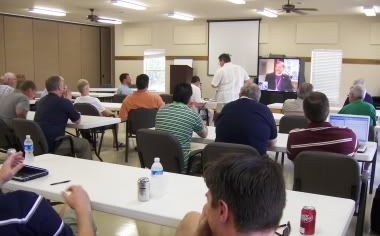
We were able to have an internet video discussion with Bishop Duncan of Pittsburgh, the ACN moderator.

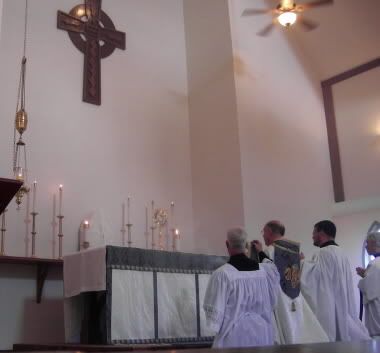
Worship in the chapel of St John the Evangelist was uplifting.
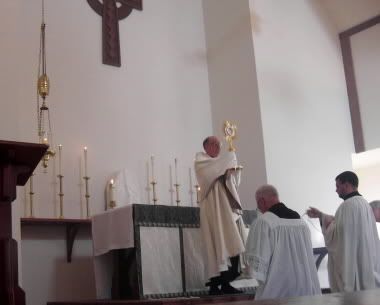
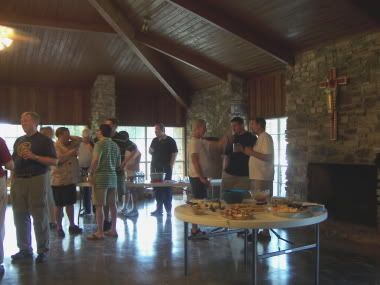
Relaxation, recreation, and fellowship with friends was just great.

Monday, August 20, 2007
My Simpsons' character

My wife visited the website of the Simpsons' Movie (which we have not seen) and found that you can create yourself as an animated character. You give descriptions of yourself and it generates your character. This is how mine turned out.
Thursday, August 16, 2007
Fun with church catalogs
Most catalogs have goofy pictures from time to time. Church catalogs seem especially prone to the this phenomenon. Here are some of my favorites, with fitting captions. Perhaps you can come up with captions of your own.
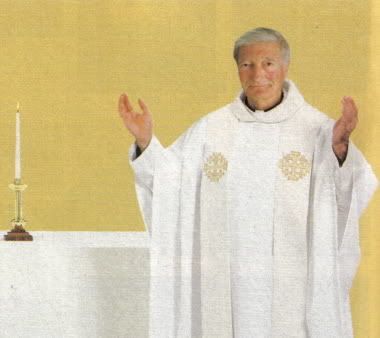
1. "Oh, it's true! I once consecrated a wafer THIS BIG."

2. "See Father Bob, it's right there like I told you. Isaiah 16:11, 'Wherefore my bowels shall sound like a harp'."
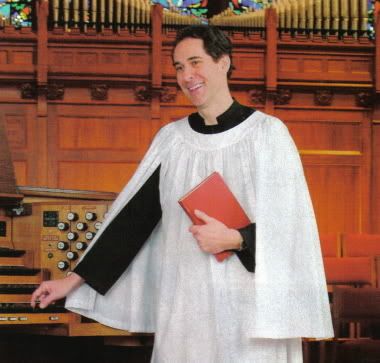
3. "Look, there's no way I'm playing that."

4. "Another kick-@$$ sermon! That's a four month winning streak now."
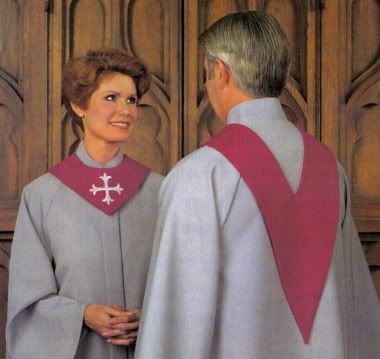
5. "Pull yourself together, Ted. I can't sing this duet by myself."
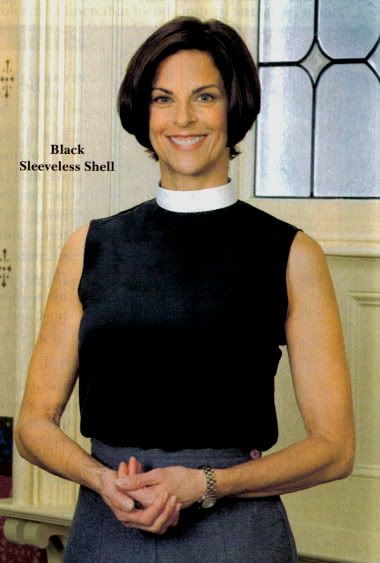
6. "If you don't give me those sleeves back, I'm gonna pound you."

7. "Look at that finger. What a finger!"
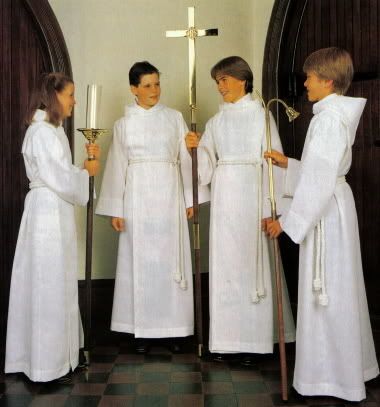
8. "If you think that's awkward, just wait till father starts to show off his finger."

9. "You gotta question? You ask the cuff link."

10. "What? You never seen a guy wearin' a big blue poncho with cartoon candles on it before?"
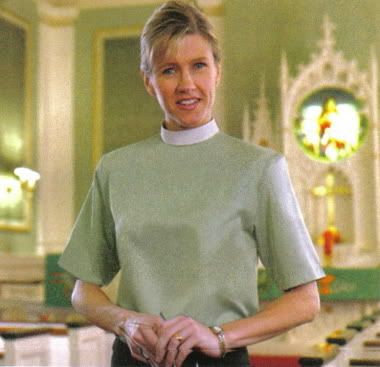
11. "Behold the spiritual excellencies of mint . . . all mint."
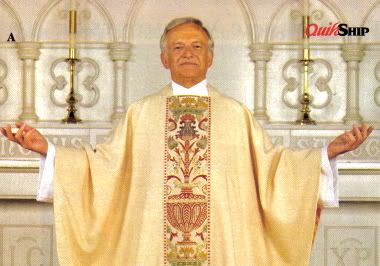
12. "Where did the missal go?"
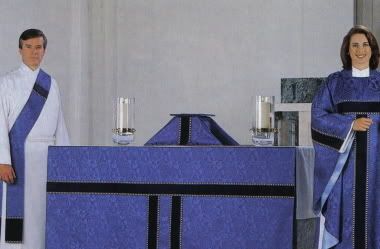
13. "Not one step closer, Roger. You keep your distance till Christmas."
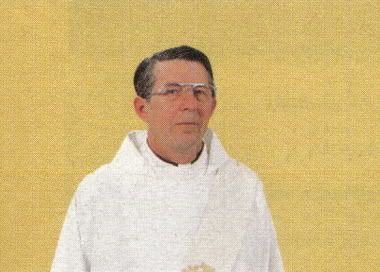
14. "Does the bishop know about this?"

1. "Oh, it's true! I once consecrated a wafer THIS BIG."

2. "See Father Bob, it's right there like I told you. Isaiah 16:11, 'Wherefore my bowels shall sound like a harp'."

3. "Look, there's no way I'm playing that."

4. "Another kick-@$$ sermon! That's a four month winning streak now."

5. "Pull yourself together, Ted. I can't sing this duet by myself."

6. "If you don't give me those sleeves back, I'm gonna pound you."

7. "Look at that finger. What a finger!"

8. "If you think that's awkward, just wait till father starts to show off his finger."

9. "You gotta question? You ask the cuff link."

10. "What? You never seen a guy wearin' a big blue poncho with cartoon candles on it before?"

11. "Behold the spiritual excellencies of mint . . . all mint."

12. "Where did the missal go?"

13. "Not one step closer, Roger. You keep your distance till Christmas."

14. "Does the bishop know about this?"
For your listening pleasure . . .

First, click here to listen to an excellent commentary on "Orthodoxy in Anglican Worship" by my friend, the Rev'd Canon Thomas Janikowski of Grace Church, Galesburg IL (pictured above). His examination of "right glory" in our worship comes as a part of the general conversation in response to the Common Cause theological statement. My favorite line is, "Worship is not for us, but for God." That is something worth remembering. (Tip of the biretta to the Common Anglican.)
Second, click here to listen to a stirring rendition of the hymn "Hail, Holy Queen Enthroned Above." The recording was made by Fr Z at the Solemn Mass for the Assumption last year at the cathedral in Camden NJ. It has been one of my favorites and was sung by the congregation at my ordination to the priesthood. (Tip of the biretta to the New Liturgical Movement.)
Happy listening.
Wednesday, August 15, 2007
Why I believe in the Assumption of Mary
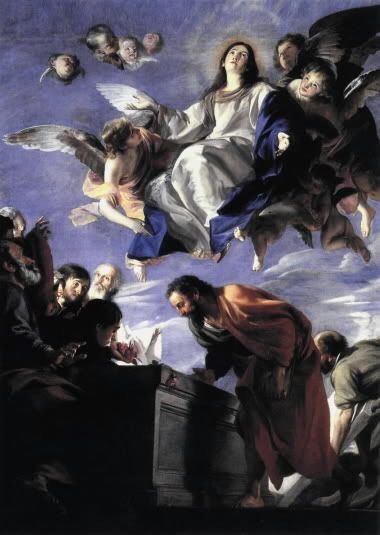
Today is the feast of St Mary the Virgin. In the Anglican Church of Canada, the Scottish Episcopal Church, and the Eastern Orthodox Church, it is called the "Falling Asleep [or Dormition] of the Blessed Virgin Mary." In the Latin West it is called the "Assumption of the Blessed Virgin Mary."
There is no substantive difference in the Roman Catholic and Eastern Orthodox doctrine, just a difference in emphasis. The Orthodox emphasize that she died and was resurrected, but that her resurrected body naturally did not continue forever on earth, but that she was taken up to be with her Son. The Catholics emphasize that she was brought to be with Jesus (body and soul) at the end of her life, not defining dogmatically whether or not she underwent physical death--free to say that she was either resurrected or "translated" (see 2 Cor 5:1-8).
The Anglican tradition, as a part of her Catholic heritage, has received the universal tradition about Mary being taken into heaven at the end of her life to be with her son. Yet, in typically Anglican fashion, has not gone into detail about the hows and whys and even ifs of the matter. It is left to the area we call "pious opinions" --venerable traditions which should be respected, but not necessarily demanded as an article of faith. It is what the Lutherans call adiaphora--things "indifferent" or non-essential.
Among Anglicans, some have automatically accepted the tradition of Mary's Assumption simply because it's "the Catholic thing to do." Others have instinctively rejected it for exactly the same reason. I am inclined to believe in the Assumption of Mary. Clearly, it is not something that is unquestionable the way the resurrection of Jesus is. Nevertheless, it is something which I find entirely (in that most Thomistic of terms) "fitting."
Stories about the end of her life began to circulate in the early Church, when the cult of shrines was gaining popularity. Where was Mary buried? Unlike Peter and Paul in Rome, she had no tomb to visit. The earliest references to the Assumption of Mary appear in the 4th (or possibly late 3rd) century in Liber Requiei Mariae (The Book of Mary's Repose). Epiphanus of Salamis gives us the earliest extended witness in the fourth century.
In the centuries that follow, several writings appear recording the traditions about her death and assumption. St John of Damascus (writing in the eighth century) relates a tradition where, during the Council of Chalcedon (AD 451), the emperor Marcian and his wife wished to find the body of Mary. He tells how all the apostles had seen her death, but her tomb was empty upon inspection. Although he did not make it an article of faith, Martin Luther said of the doctrine of the Assumption: "There can be no doubt that the Virgin Mary is in heaven. How it happened we do not know."
Some object that it is not described in the Bible. And they are correct, it is never explicitly described in holy Scripture. But does that mean it did not happen? The Bible also never records the death of St Peter or St Paul, but Christian tradition does, and I am inclined to believe that it is correct about it--not just the fact that they died, but also the where and how and why.
However, it is very possible that the Scriptures allude to her place in heaven. There is biblical precedent for the event in the assumptions of Enoch (Gen 5:34) and Elijah (2 Kings 2:11). Also, it is possible that she is pictured in the heavenly vision of St John. Revelation 11:19--12:5 reads as follows:
"Then God's temple in heaven was opened, and within his temple was seen the ark of his covenant. And there came flashes of lightning, rumblings, peals of thunder, an earthquake and a great hailstorm. A great and wondrous sign appeared in heaven: a woman clothed with the sun, with the moon under her feet and a crown of twelve stars on her head. She was pregnant and cried out in pain as she was about to give birth. Then another sign appeared in heaven: an enormous red dragon with seven heads and ten horns and seven crowns on his heads. His tail swept a third of the stars out of the sky and flung them to the earth. The dragon stood in front of the woman who was about to give birth, so that he might devour her child the moment it was born. She gave birth to a son, a male child, who will rule all the nations with an iron scepter. And her child was snatched up to God and to his throne."
There is always a certain plasticity to the symbolic images (not to mention time-lines) in Revelation. The woman and the child end up signifying the people of God. But at first, they clearly represent Mary and Jesus. The child is the Messiah (and of course, Mary is the mother of the Messiah). Also, we should be aware of the Ark of the Covenant as a symbol for Mary; as the bearer of Jesus (the bread from heaven, the new Torah, the blossomed priestly staff), Mary is the Ark of the New Covenant.
So John tells us in Revelation that he saw Mary in heaven, crowned in glory. As the one entrusted with her care, it was surely a moment of awe and comfort that she was safely at home. Some would object that she is not identified by name here; it is only an unnamed mother. That is correct, but it is also typical of St John, for in his gospel Mary is never mentioned by name. Out of deep respect, she is always referred to as "mother" or "woman."
Looking at the Old Testament the way the early Church fathers did, we also see typical allusions which might apply to Mary's Assumption. Paslm 132:8 and 2 Chronicles 6:41 are fitting heralds of the Ascension and Assumption: "Now arise, O LORD God, and come to your resting place, you and the ark of your strength." The description of the old ark's placement in the Holy of Holies of the temple (which represents heaven) also applied to the Assumption: "The priests then brought the ark of the LORD's covenant to its place in the inner sanctuary of the temple, the Most Holy Place, and put it beneath the wings of the cherubim" (1 Kings 8:6).
The description of David preparing a place for the ark mirrors the words of Jesus (the Son of David) words about preparing a place for Mary and all the saints. Compare, "After David had constructed buildings for himself in the City of David, he prepared a place for the ark of God and pitched a tent for it" (1 Chronicles 15:1) with "
"In those days, when your numbers have increased greatly in the land," declares the LORD, "men will no longer say, 'The ark of the covenant of the LORD.' It will never enter their minds or be remembered; it will not be missed, nor will another one be made" (Jeremiah 3:16). "Above the ark were the cherubim of the Glory, overshadowing the atonement cover. But we cannot discuss these things in detail now" (Hebrews 9:5).
As has been often said, Mary was the first disciple, and we see all God's promises for Christian disciples first fulfilled in her. What happens to Mary is a sign of God's gift to every believer--a new resurrected body, being taken to be with Jesus, and being rewarded (or "crowned") with eternal life. We see this in St Paul's comments on the subject.
"And just as we have borne the likeness of the earthly man, so shall we bear the likeness of the man from heaven. I declare to you, brothers, that flesh and blood cannot inherit the kingdom of God, nor does the perishable inherit the imperishable. Listen, I tell you a mystery: We will not all sleep, but we will all be changed—in a flash, in the twinkling of an eye, at the last trumpet. For the trumpet will sound, the dead will be raised imperishable, and we will be changed. For the perishable must clothe itself with the imperishable, and the mortal with immortality" (1 Cor 15:49-53).
"According to the Lord's own word, we tell you that we who are still alive, who are left till the coming of the Lord, will certainly not precede those who have fallen asleep. For the Lord himself will come down from heaven, with a loud command, with the voice of the archangel and with the trumpet call of God, and the dead in Christ will rise first. After that, we who are still alive and are left will be caught up together with them in the clouds to meet the Lord in the air. And so we will be with the Lord forever. Therefore encourage each other with these words" (1 Thess 4:15-18).
"I have fought the good fight, I have finished the race, I have kept the faith. Now there is in store for me the crown of righteousness, which the Lord, the righteous Judge, will award to me on that day—and not only to me, but also to all who have longed for his appearing" (2 Tim 4:7-8).
The Collect (BCP, p 192)
O God, who hast taken to thyself the blessed Virgin Mary, mother of thy incarnate Son: Grant that we, who have been redeemed by his blood, may share with her the glory of thine eternal kingdom; through the same thy Son Jesus Christ our Lord, who liveth and reigneth with thee, in the unity of the Holy Spirit, one God, for ever and ever. Amen.
Hymn 278 (The Hymnal 1982)
4. Sing the chiefest joy of Mary when on earth her work was done
and the Lord of all creation brought her to his heavenly home;
where, raised high with saints and angels, in Jerusalem above,
she beholds her Son and Savior reigning as the Lord of love.
Tuesday, August 14, 2007
Evensong for the Vigil of the Assumption
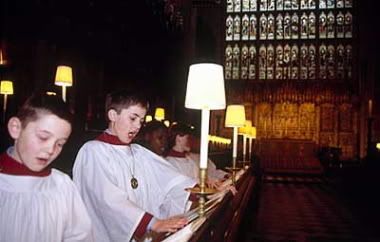
Antiphon on the Magnificat
O wisest of virgins, whither goest thou, like to the Day-Spring gloriously rising? * O daughter of Sion, altogether lovely art thou, and pleasant for delights, fair as the moon, clear as the sun.
Collect
O God, who didst vouchsafe to choose the Virgin womb of blessed Mary wherein to make thy dwelling-place: Grant, we beseech thee, that we, being defended by her protection, may of thee be enabled to attain with gladness to her coming festival; who livest and reignest with the Father and the Holy Ghost, ever one God, world without end. Amen.
Thursday, August 09, 2007
An English constitutional question
Reading through Bishop Moorman's book on English church history, I came across a question that perhaps our friends across the pond or someone else in the know may be able to help me with.
The Magna Carta, after the introduction, begins thus:
"First, that we have granted to God, and by this present charter have confirmed for us and our heirs in perpetuity, that the Church of England [Anglicana ecclesie] shall be free, and shall have its rights undiminished, and its liberties unimpaired. . . . This freedom we shall observe ourselves, and desire to be observed in good faith by our heirs in perpetuity."
How does this square with Henry VIII becoming the Supreme Head of the Church of England by the 1534 Act of Supremacy? One of the main issues that brought about the Magna Carta was whether the church has the right to make its own appointments and govern its own affairs or whether it is subject to the crown.
Is the Act of Supremacy unconstitutional? Does the apparent unconstituntionality of the new act which has stood the test of time simply set a precedent and in effect amend the English constitution (which is not a single document to begin with, but rather a body of law built on precedent)? Perhaps you can help me figure it out.
The Magna Carta, after the introduction, begins thus:
"First, that we have granted to God, and by this present charter have confirmed for us and our heirs in perpetuity, that the Church of England [Anglicana ecclesie] shall be free, and shall have its rights undiminished, and its liberties unimpaired. . . . This freedom we shall observe ourselves, and desire to be observed in good faith by our heirs in perpetuity."
How does this square with Henry VIII becoming the Supreme Head of the Church of England by the 1534 Act of Supremacy? One of the main issues that brought about the Magna Carta was whether the church has the right to make its own appointments and govern its own affairs or whether it is subject to the crown.
Is the Act of Supremacy unconstitutional? Does the apparent unconstituntionality of the new act which has stood the test of time simply set a precedent and in effect amend the English constitution (which is not a single document to begin with, but rather a body of law built on precedent)? Perhaps you can help me figure it out.
Tuesday, August 07, 2007
Misusing Scripture to "Get Out of Jail Free"
I received my new issue of the LCMS journal Issues, etc (supporting the radio program with the same name) yesterday. Although much of the content covers "in-house" Lutheran concerns, it is all interesting, and much of it very thought provoking.
In this issue, Pastor Todd Wilken had a article called "Getting Out of Jail Free: Misusing Scripture as an Excuse for Sin." Intrigued, I read on. When I came to the first example, it all became so obvious. I bet you can guess some of them. They are those verses often quoted by someone who was just caught red-handed morally or doctrinally. Here are the excuse verses which Wilken refutes in the article.
Matthew 7:1
"Judge not, lest ye be judged."
John 8:7
"He that is without sin among you, let him cast the first stone."
1 Corinthians 13:12
"We see though a glass, darkly."
1 Corinthians 8:1
"Knowledge puffs up, but love builds up."
Titus 3:9
"Avoid foolish controversies"
In this issue, Pastor Todd Wilken had a article called "Getting Out of Jail Free: Misusing Scripture as an Excuse for Sin." Intrigued, I read on. When I came to the first example, it all became so obvious. I bet you can guess some of them. They are those verses often quoted by someone who was just caught red-handed morally or doctrinally. Here are the excuse verses which Wilken refutes in the article.
Matthew 7:1
"Judge not, lest ye be judged."
John 8:7
"He that is without sin among you, let him cast the first stone."
1 Corinthians 13:12
"We see though a glass, darkly."
1 Corinthians 8:1
"Knowledge puffs up, but love builds up."
Titus 3:9
"Avoid foolish controversies"
Monday, August 06, 2007
Does it have anything to do with the Turks?

Today, we celebrate the feast of the Transfiguration of our Lord Jesus Christ. Although we read the story on the last Sunday before Lent begins in the new lectionary, the feast day always falls on August 6th.
In the story, Peter offers to construct tabernacles (or "booths") for Jesus, Moses, and Elijah, telling us that the event is occurring at the Hebrew feast of Succoth (the feast of Tabernacles), which falls in the month of October. So how did the Christians end up commemorating the Transfiguration (which must have occurred in October) on August 6th?
The feast originated in the Eastern Church, becoming widely observed by the end of the first millennium on the 6th of August. From there it spread to the Western Church, but was not universally observed there. Many places in the West observed it on August 6th, others kept the feast on different dates. In Gaul and England in was 27 July; at Meissen, 17 March; and at Halberstadt, 3 September.
The deciding factor would come a few centuries later out of the clash of Moslems and Christians. August 6th was universally established as the date for the feast in the Latin rite by Pope Callistus III to mark the victory of Hunyady and the resulting Christian deliverance from the Turks at Belgrade on August 6, 1456.
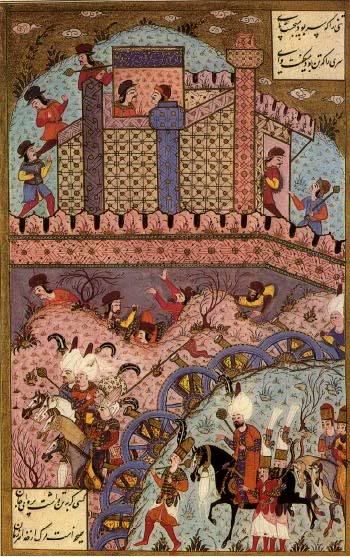
All is vanity?
A sermon for Proper 13, given on 5 August 2007 at St. Alban's, Arlington.
Ecclesiastes is not a well-loved book of the Bible. It seems to be no one’s favorite. With lines like “I considered all that my hands had done, and the toil I had spent in doing it, it was all vanity—chasing after the wind—and there was nothing to be gained under the sun”, we can see why few would want to hear what the Preacher (or in this translation, the “Teacher”) would have to say.
With so few fans, one wonders how Ecclesiastes found its way into the Bible at all. But there was at least one person who got excited about it. According to his student Reginald Fuller, the Anglican New Testament scholar Edwyn Hoskyns was fond of saying that Ecclesiastes was the most Christian book of the Old Testament. What he meant by that statement was that Ecclesiastes is a ruthless exposure of what human life is like apart from God, and so it has the blessing of preparing the heart to receive the gospel. That is, Ecclesiastes is not so much good news, as it is bad news—the kind of bad news that shows us just how good the “good news” really is, and which makes the gospel message audible to the broken-hearted.
“Vanity of vanities”, the book begins, “all is vanity.” All of human life is futile and meaningless, when viewed apart from God. In a temporal perspective, even a life lived well seems lived in vain. “Vanity” is the refrain carried throughout the book.
The Hebrew word for vanity is curious—abhel. It literally means “vapor” as in the moist puff of someone who is short of breath, toiling endlessly under the sun. It could also be translated “mystery”, as in a fog where things are unclear and hard to discern. As you may have guessed, abhel is also the name of Adam’s son Abel, who was murdered by his brother Cain.
“Vanity of vanities, all is vanity!” What is life good for? What are doing with it? Are all our blood, sweat, and tears really worth anything in the end? How come sometimes things just don’t work out? Why do bad things happen to good people, like poor Abel? Mystery of mysteries, it is all a mystery!
This week, we saw a chapter close in that outreach ministry of our church which began with a request for Kindergarten from the city back in 1958 and grew up into St. Alban’s Episcopal School, serving Pre-K—12. There are some who will reflect upon the history—the visionary contributions and tireless labor of people like our first Rector, Fr. Walter Harrison Beste, who accepted such a challenge for our young church, and of Marge O’ Halloran, who was entrusted with responsibility for its development and leadership from the ground up. Some will reflect upon the dedicated efforts of teachers, volunteers, and parents, upon the endless expenditure of construction paper, paste (some of it digested), and crayons, of field trips, milk cartons, science lab equipment, and uniforms . . .
And some will say, with the Preacher, It wasn’t worth it. It was all in vain. “I considered all that my hands had done and the toil I had spent in doing it, and again, all was vanity and a chasing after the wind, and there was nothing to be gained under the sun.” If we had known it would all end up in bankruptcy and pointed fingers, we should never have done any of it in the first place. As a matter of fact, some of us did know—we figured it out, we saw it coming, we could see it would end like this sooner or later, and (you know what?) . . . I told you so! Vanity of vanities.
And then there are others who do not join the voice of the Preacher, except perhaps to enter into that struggle humbly—putting off judgment. Mystery of mysteries. It is all a mystery. Was it all worth it? Did we accomplish what we set out to accomplish? Where is the wisdom of God to be found in our history?
They too will ponder the endless expenditure of construction paper, paste, (some of it digested) and crayons, of field trips, milk cartons, science lab equipment, and uniforms, the noble sacrifices of individual leaders, the dedicated efforts of parents, volunteers, and of teachers, and so forth. But they will begin to see more and more a glowing and marvelous Christian witness—people who were more concerned with doing some bit of good in the world than in their own interest or in counting the personal costs. They will see a generational school community, which like our patron, blessed Alban, was faithful even unto death.
The rewards will not be found in a lasting institution, but in human lives, instilled through bygone moments of learning, caring, growing, nurture and play. It is an utterly Christian thing to find nobility in the futility of love, to see grace in the pouring out of oneself even unto death. Sometimes our biggest failures are exactly our most vivid testimonies to the grace and love and mercy of God known to us in the cross of Jesus.
Remember, the apostles recognized the risen Lord when he showed them his wounds—his hands, his feet, his side. They recognized him by the signs of his suffering. Sometimes that is how people recognize Christians. Jesus’ formation of his disciples did not end in parables and pronouncements. It ended in blood, tears, sweat, nails, and wood, with the final vapor of breath squeezed out of his sacred body before family, friends, and mostly strangers on the cross of Calvary’s hill. What were the rewards? Was it all in vain?
The disciple says, It was worth it. He did this for us. He suffered for our salvation. And he did so, St Peter tells us, to "give us an example that we should follow in his steps" (see 1 Peter 2:20-21). This is essentially St Paul’s idea in today’s epistle: to be joined to Christ is to have a new kind of existence, a new life in which life is now lived for others.
No parable could truly teach the disciples what they could only learn by example through the bloody cross and the empty tomb. To be Christian disciples means to give ourselves away . . . to God, to each other, and to the world.
The gospel reading today draws together the thoughts of the first two readings and gives them precision. It begins with pointed fingers—a bitter family dispute. “Teacher”, someone called out to Jesus, “tell my brother to divide the family inheritance with me.” How often have we seen this after someone dies?
Jesus warned this man and others to guard against greed in all forms—to remember that life does not consist in the abundance of things. The older translation is to guard against all forms of “covetousness.” After all, why is this man so concerned about his inheritance? Is it because of a noble and disinterested concern for justice? Or is it a fixation on the material gains that are his rightful inheritance. No one is saying he doesn’t deserve the money. But Jesus reminds us to consider our motives and perspectives.
"Life does not consist in the abundance of things." That verse in the Greek text is idiomatic; it is difficult to translate exactly. One scholar put it this way: “A man’s life does not belong to him no matter how rich he is.” Another commentator suggested, “Because a man has abundance, it does not follow that life consists in amassing wealth.” Or to turn to the Fr Matkin translation (which is not always literally correct, but may get the point across): “As odd as it may seem, sometimes God may want us to get the short end of the stick.”
That news can be hard to swallow, so Jesus told them a parable. His story is essentially a quotation from Old Testament book called Sirach (Ecclesiasticus 11:18-19) There was a rich man who was actually a fool in God's sight, for he lived his life without regard to God and was caught in the toils of futility and vanity. He saw life only with a temporal perspective; he did not “seek the things that are above.”
The land he owned produced plentifully, business was booming, and his biggest problem
was figuring out where to put it all. "Should I build new and larger barns?" he questioned. What problems to have! He never would have thought he had a care in the world. Because of his wisdom, his retirement would be occupied with eating, drinking, and being merry (taking cruises to the Virgin Islands, etc). Who among us would not envy that for ourselves?
Then comes the crashing judgment: “This night your soul is required of you.” That is, "You’re going to die, tonight." Because he thought his own existence was under his own control, it came as a shock to learn that it was God’s to give and God’s to take away again. With his perspective, the rich fool cannot help but consider his life a vain pursuit in the end. He had measured himself according to a worldly standard (a temporal perspective), and found himself confident, wise, and successful. But when he was forced to measure himself against God’s standard (an eternal perspective), the rich fool found himself wanting.
We see that eternal perspective in Jesus’ own life and mission. He was born to endure the cross; he directed his life toward suffering. The rich fool, would have never have willingly gone to the cross. At the end of Luke's gospel, we see the two perspectives contrasted in the two thieves crucified with Jesus.
One turns to Jesus and says, echoing the scoffers below, “Aren’t you the Messiah? Can’t you save us from all this?” The second thief reminds the first, “We deserve to be here, but this man is innocent.” And we see his eternal perspective when the second thief turns to Jesus and says, “Lord, remember me when you come into your kingdom.” Jesus says to him, “You will be with me this day in paradise.” The second thief and Jesus shared an eternal perspective.
The book of Hebrews tells us “it was for the joy that was set before him” (the joy of things like giving paradise to this poor sinner) that Jesus “endured the cross, despising the shame, and is now seated at the right hand of the throne of God.” Following Christ means giving ourselves away—to God, to each other, and to the world.
“Vanity of vanities?” Some would undoubtedly say so. “Mystery of mysteries?” Of that, we can all be certain.
Ecclesiastes is not a well-loved book of the Bible. It seems to be no one’s favorite. With lines like “I considered all that my hands had done, and the toil I had spent in doing it, it was all vanity—chasing after the wind—and there was nothing to be gained under the sun”, we can see why few would want to hear what the Preacher (or in this translation, the “Teacher”) would have to say.
With so few fans, one wonders how Ecclesiastes found its way into the Bible at all. But there was at least one person who got excited about it. According to his student Reginald Fuller, the Anglican New Testament scholar Edwyn Hoskyns was fond of saying that Ecclesiastes was the most Christian book of the Old Testament. What he meant by that statement was that Ecclesiastes is a ruthless exposure of what human life is like apart from God, and so it has the blessing of preparing the heart to receive the gospel. That is, Ecclesiastes is not so much good news, as it is bad news—the kind of bad news that shows us just how good the “good news” really is, and which makes the gospel message audible to the broken-hearted.
“Vanity of vanities”, the book begins, “all is vanity.” All of human life is futile and meaningless, when viewed apart from God. In a temporal perspective, even a life lived well seems lived in vain. “Vanity” is the refrain carried throughout the book.
The Hebrew word for vanity is curious—abhel. It literally means “vapor” as in the moist puff of someone who is short of breath, toiling endlessly under the sun. It could also be translated “mystery”, as in a fog where things are unclear and hard to discern. As you may have guessed, abhel is also the name of Adam’s son Abel, who was murdered by his brother Cain.
“Vanity of vanities, all is vanity!” What is life good for? What are doing with it? Are all our blood, sweat, and tears really worth anything in the end? How come sometimes things just don’t work out? Why do bad things happen to good people, like poor Abel? Mystery of mysteries, it is all a mystery!
This week, we saw a chapter close in that outreach ministry of our church which began with a request for Kindergarten from the city back in 1958 and grew up into St. Alban’s Episcopal School, serving Pre-K—12. There are some who will reflect upon the history—the visionary contributions and tireless labor of people like our first Rector, Fr. Walter Harrison Beste, who accepted such a challenge for our young church, and of Marge O’ Halloran, who was entrusted with responsibility for its development and leadership from the ground up. Some will reflect upon the dedicated efforts of teachers, volunteers, and parents, upon the endless expenditure of construction paper, paste (some of it digested), and crayons, of field trips, milk cartons, science lab equipment, and uniforms . . .
And some will say, with the Preacher, It wasn’t worth it. It was all in vain. “I considered all that my hands had done and the toil I had spent in doing it, and again, all was vanity and a chasing after the wind, and there was nothing to be gained under the sun.” If we had known it would all end up in bankruptcy and pointed fingers, we should never have done any of it in the first place. As a matter of fact, some of us did know—we figured it out, we saw it coming, we could see it would end like this sooner or later, and (you know what?) . . . I told you so! Vanity of vanities.
And then there are others who do not join the voice of the Preacher, except perhaps to enter into that struggle humbly—putting off judgment. Mystery of mysteries. It is all a mystery. Was it all worth it? Did we accomplish what we set out to accomplish? Where is the wisdom of God to be found in our history?
They too will ponder the endless expenditure of construction paper, paste, (some of it digested) and crayons, of field trips, milk cartons, science lab equipment, and uniforms, the noble sacrifices of individual leaders, the dedicated efforts of parents, volunteers, and of teachers, and so forth. But they will begin to see more and more a glowing and marvelous Christian witness—people who were more concerned with doing some bit of good in the world than in their own interest or in counting the personal costs. They will see a generational school community, which like our patron, blessed Alban, was faithful even unto death.
The rewards will not be found in a lasting institution, but in human lives, instilled through bygone moments of learning, caring, growing, nurture and play. It is an utterly Christian thing to find nobility in the futility of love, to see grace in the pouring out of oneself even unto death. Sometimes our biggest failures are exactly our most vivid testimonies to the grace and love and mercy of God known to us in the cross of Jesus.
Remember, the apostles recognized the risen Lord when he showed them his wounds—his hands, his feet, his side. They recognized him by the signs of his suffering. Sometimes that is how people recognize Christians. Jesus’ formation of his disciples did not end in parables and pronouncements. It ended in blood, tears, sweat, nails, and wood, with the final vapor of breath squeezed out of his sacred body before family, friends, and mostly strangers on the cross of Calvary’s hill. What were the rewards? Was it all in vain?
The disciple says, It was worth it. He did this for us. He suffered for our salvation. And he did so, St Peter tells us, to "give us an example that we should follow in his steps" (see 1 Peter 2:20-21). This is essentially St Paul’s idea in today’s epistle: to be joined to Christ is to have a new kind of existence, a new life in which life is now lived for others.
No parable could truly teach the disciples what they could only learn by example through the bloody cross and the empty tomb. To be Christian disciples means to give ourselves away . . . to God, to each other, and to the world.
The gospel reading today draws together the thoughts of the first two readings and gives them precision. It begins with pointed fingers—a bitter family dispute. “Teacher”, someone called out to Jesus, “tell my brother to divide the family inheritance with me.” How often have we seen this after someone dies?
Jesus warned this man and others to guard against greed in all forms—to remember that life does not consist in the abundance of things. The older translation is to guard against all forms of “covetousness.” After all, why is this man so concerned about his inheritance? Is it because of a noble and disinterested concern for justice? Or is it a fixation on the material gains that are his rightful inheritance. No one is saying he doesn’t deserve the money. But Jesus reminds us to consider our motives and perspectives.
"Life does not consist in the abundance of things." That verse in the Greek text is idiomatic; it is difficult to translate exactly. One scholar put it this way: “A man’s life does not belong to him no matter how rich he is.” Another commentator suggested, “Because a man has abundance, it does not follow that life consists in amassing wealth.” Or to turn to the Fr Matkin translation (which is not always literally correct, but may get the point across): “As odd as it may seem, sometimes God may want us to get the short end of the stick.”
That news can be hard to swallow, so Jesus told them a parable. His story is essentially a quotation from Old Testament book called Sirach (Ecclesiasticus 11:18-19) There was a rich man who was actually a fool in God's sight, for he lived his life without regard to God and was caught in the toils of futility and vanity. He saw life only with a temporal perspective; he did not “seek the things that are above.”
The land he owned produced plentifully, business was booming, and his biggest problem
was figuring out where to put it all. "Should I build new and larger barns?" he questioned. What problems to have! He never would have thought he had a care in the world. Because of his wisdom, his retirement would be occupied with eating, drinking, and being merry (taking cruises to the Virgin Islands, etc). Who among us would not envy that for ourselves?
Then comes the crashing judgment: “This night your soul is required of you.” That is, "You’re going to die, tonight." Because he thought his own existence was under his own control, it came as a shock to learn that it was God’s to give and God’s to take away again. With his perspective, the rich fool cannot help but consider his life a vain pursuit in the end. He had measured himself according to a worldly standard (a temporal perspective), and found himself confident, wise, and successful. But when he was forced to measure himself against God’s standard (an eternal perspective), the rich fool found himself wanting.
We see that eternal perspective in Jesus’ own life and mission. He was born to endure the cross; he directed his life toward suffering. The rich fool, would have never have willingly gone to the cross. At the end of Luke's gospel, we see the two perspectives contrasted in the two thieves crucified with Jesus.
One turns to Jesus and says, echoing the scoffers below, “Aren’t you the Messiah? Can’t you save us from all this?” The second thief reminds the first, “We deserve to be here, but this man is innocent.” And we see his eternal perspective when the second thief turns to Jesus and says, “Lord, remember me when you come into your kingdom.” Jesus says to him, “You will be with me this day in paradise.” The second thief and Jesus shared an eternal perspective.
The book of Hebrews tells us “it was for the joy that was set before him” (the joy of things like giving paradise to this poor sinner) that Jesus “endured the cross, despising the shame, and is now seated at the right hand of the throne of God.” Following Christ means giving ourselves away—to God, to each other, and to the world.
“Vanity of vanities?” Some would undoubtedly say so. “Mystery of mysteries?” Of that, we can all be certain.
Thursday, August 02, 2007
No more classes, no more books . . .
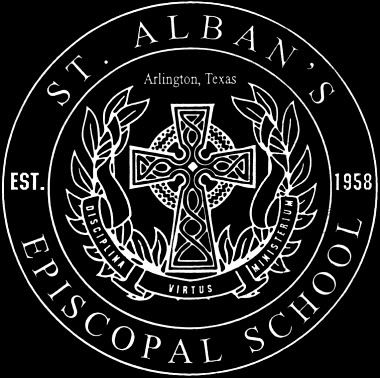
When summer approaches, the refrain is "No more classes, no more books, no more teachers, dirty looks" (at least, according to Bugs Bunny). During the school year, students are watching and waiting for any chance of snow, which might mean no school. Some even dream of the day when the school might burn down. It's just part of being a kid.
But I think the children who go to St. Alban's Episcopal School will instead be saddened by the news that the school will not open again in the Fall. They will have to go to school somewhere, of course. I'm sure that's when it will really start to sink in . . . it just won't be the same.
The school struggled financially around the 1999/2000 school year (not exactly sure about the date), and was never able to fully recover. The bold move to a new campus, which sought to address many long-term needs, was simply not enough to bring it back to a solid footing.
There are many wonderful children and families that we have been blessed to serve. It is a community that will be lost. I grieve over that. So many parents and others in our extended family put down their hard earned cash to help secure the school's future. And there are many faculty and staff who have worked very hard andpassed up more lucrative salaries elsewhere and even accepted pay cuts to help the school survive. I hope their sacrifices will one day be rewarded.
Right before I came to St. Alban's Episcopal Church, the chaplain (who worked for the school) had moved to France. Instead of trying to hire a new chaplain, the clergy at the church began to fill that role by teaching classes and leading worship. I have done so for three years now, and I will miss it. Sometimes it has been aggravating (mostly 7th graders) or stressful, but it has always been so rewarding. I already miss doing Morning Prayer with the children, and I know I will miss the dramatic stations of the cross when Holy Week rolls around.
Here are some of my favorite school pictures.
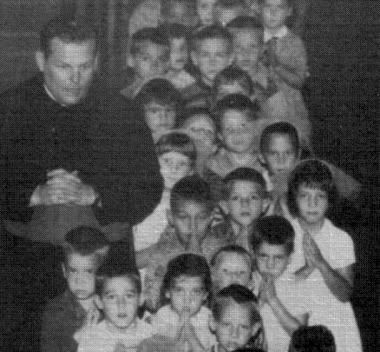
Fr. Beste showing some school children how to go into chapel.

One of my religion classes; at the time, they were 4th graders.
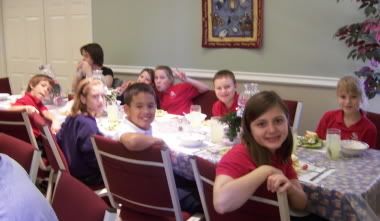
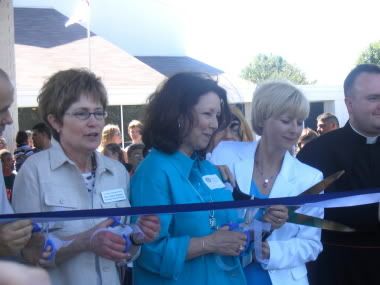
The official opening of the new campus, which is pictured below.


I thought the picture of this student came out perfectly.

The students gave all the input last year for us to come up with our school prayer which we used in chapel for the rest of the year. It goes like this:
MERCIFUL FATHER, from whom all good things come, you have brought us together as St Alban’s Episcopal School: Watch over us, we pray, that the good work which you have begun in us may be a blessing to you and your people from generation to generation; through Jesus Christ our Lord. Amen.

But, of course, it would be hard to top this.

Subscribe to:
Comments (Atom)

